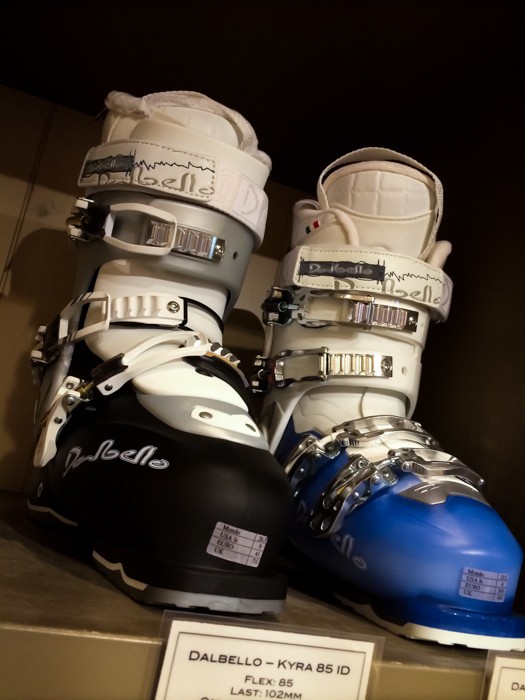
Ski Boot Fitting: Getting It Right the First Time
Properly fitted ski boots are the connection between your body and the ski, making them a crucial part of the performance formula. They also make a difference in your comfort throughout the day. However, ski boot fitting can be a frustrating process.
Ski boots aren’t designed to be bedroom-slipper comfy, but toe numbing, shin bruising, boots can wreck your day. Striking the right balance means investing in a pair of properly fitted boots. This is why I wanted to move out of rental boots as soon as possible. I learned quickly, borrow ski pants, a coat, and even skis, but invest (time and money) in good boots. Ski boots aren’t something you just walk in and buy off the shelf. There is a process to fitting them, which includes preparation and finding the right help.
I lived in Florida when I first learned to ski. Needless to say, there weren’t many places to buy ski boots, and the shops we did have weren’t nearly as experienced at fitting as those near resorts. It became clear that if I wanted new boots, I’d have to buy them while visiting Utah. Before buying, I spent time researching and asking for boot fitter recommendations. Fortunately, I had a great experience and love my boots. Since then, I’ve learned even more about the process. Here are some tips to make your ski boot fitting experience successful the first time.
Ski Boot Buying Tips
Prepare
1) Find an experienced and talented boot fitter - This is a purchase best made locally. As time passes, you’ll possibly need adjustments made, so a relationship with a local shop will come in handy. Ask avid skiers for “boot savant” recommendations.
I tracked down such a savant in Salt Lake City. Chris O’Connor, owner of InkLine Foot Science, specializes in fitting the most challenging skiers, including many with injuries and disabilities. When someone has gone through numerous fittings without success, this is where they finally find comfort and performance. His record is fitting a man who’d tried 16 other shops before walking through his door. “When someone can finally enjoy skiing again because of my fitting, that what I live for,” O’Connor shared, visibly excited.
In addition to my research, I asked O’Connor for some tips. In the brief time I spent with him I learned more about the mechanics of our feet than in the past 45 years. The biggest takeaway was that fitting a foot, a part of our body perfectly designed to move, then locking it into place, isn’t easy. The forces involved include compression, torque, and more. Now let’s make all of that really cold…. Yikes! There’s a lot to consider.
“The fact is that your balance and over all wellness starts at your foundation, and your foundation is your feet. The body, if compared to a chain, works in unison from one link to the next. Lets start by fixing one end of the chain, ‘THE BUSINESS END.’” ~ Inkline Website
2) Make and appointment and schedule several hours for your fitting - The process can’t be rushed and usually takes two to three hours to do right, explained O’Connor.
Tip: Buy your boots at a slow time of day, during the week, or even off-season, to ensure you have the fitter’s undivided attention.
3) Groom and dress for the occasion - Prepare for the fitting by clipping your toenails and wearing shorts our loose pants that can pull up to the knee. Bring the same socks you will wear on the slopes with you to the fitting. Preferably a single pair of thin, snug, wool or synthetic socks. Don’t skimp and wear dress or cotton socks. Instead, invest in a pair that will take care of you.
4) Understand the fitting process so that you can play an active role - This is especially important if you don’t have access to an expert fitter or if you aren’t confident they have a lot of experience. Reading reputable information on boot fitting is a good start.
5) Be open-minded and ready to learn.

The Fitting Process
1) Q & A - The fitter will need to know you level of expertise. Be honest, this isn’t the time to let your pride get in the way of your comfort.
2) Foot measurement – Both the length and width of your foot impact which brands and models will fit the best. The fitter will also look for imbalances or other physical traits that may impact your fit.
“We guarantee our fit and want your boots to fit right out of the gate,” shared O’Connor. “I don’t believe in making customers come back 2-3 times to dial in the fit.”
3) Try on boots – Based on your Q & A and measurements, the fitter will give you several boots to try on.
If you’ve found a fitter with an excellent reputation, “Trust them! They have years of experience doing their job,” advised O’Connor. He went on to share that many clients are surprised by the boots or sizing the fitter recommends and object. This is where trust and open-mindedness comes in.
Face it, if you could fit them yourself, you would have. My words, but I suspect that’s how Chris would say it too. Let’s not be too tender here. This is about getting results. Okay, off my soapbox and back to the process…
Try on the shell with the liner removed - Position your toes flat and just touching the front of the shell. You should have about ½ to ¾ of an inch of space between your heel and the back of the shell.
Next press your heel against the back of the shell - Note the space between the boot break (that angle on the front where it transitions from the horizontal to vertical) and the same curve at the top of your ankle. Look for between ¾ to 1½ inches of space. “The fit of the boot at the break is critical,” emphasized O’Connor, “if the fitter isn’t looking at this, you have a novice. The break determines where the foot will sit in the boot.”
Try on the liner - It should fit snug and align to the shape of your foot.
Lastly place the liner back into the shell and try them on together - Properly fitted boots should feel uniformly tight, like a handshake (with no pressure points), but not painful. The foot should sit flat and the toes just brushing the front of the boot with room to wiggle while standing, and then pull away when the leg is flexed. Your heel should remain in place and not slip as you flex.
4) Decide if you want a custom liner or foot bed - Custom liners and or foot-beds can make a large difference in the performance and fit of your boot.
Hint: If you’re on vacation and want to enjoy your boots right away, go for a custom liner. They will let you skip past the break-in period you would have with stock liners. Consider how much you’ve spent on your vacation and new boots, adding the cost of a liner to make your skiing comfortable from day one isn’t that much in comparison.
The time to add liners is during the fitting so that your boots can be sized to accommodate.
5) Spend at least 10-15 minutes in your top picks - Boots that feel good initially may reveal pressure points over time, while others may fit better.
6) Final adjustments - Once you’ve settled on a pair of boots, the technician will do final adjustments and custom fitting.

Ski boots may not be sleek and sexy, but the time and money you spend on them will be rewarded in performance and comfort on a powder day.
Chris O’Connor and his team at Inkline are a fabulous resource if you are able to make it to Salt Lake City. If you’re visiting from out of town, make an appointment in advance and head to the shop on the way to the mountain. The crew at Inkline is flexible if your arrival is outside their normal hours, but it helps if they know in advance. “We’ll stay…and fit a whole family if it will allow them to hit the slopes in the morning.” With this comment, realized this was more than a business to him, it was a passion and calling.
Because they’ve spent their careers in the industry, Inkline understands that a many snow sports professionals don’t earn a lot. “We work with industry professionals who serve the sport, offering discounts and accommodating most budgets,” said O’Connor.
In the end, what I took away from meeting with Chris O’Connor is that the Inkline team is passionate about the ski industry. Specifically, making it fun and comfortable for everyone. I wish I had room here to convey all he shared with me, but I can say without reservation that I was impressed by his passion, knowledge, and professionalism.
Inkline Foot Science is located at: 2917 E 3300 S, Salt Lake City, Utah, 84109 and can be reached at: 801-486-6999 or visit their website InkLineFootScience.com. Appointments are strongly suggested during winter, but don’t be afraid to ask if they can squeeze you in without one.










2 Comments
Grayson Davis \ 9.4 years ago
Best bootfitter around...Chris does it right the first time.
Luu Kee \ 9.4 years ago
Sounds like a great shop to get my flat & funky size 14s dialed in. Proof is in their customer base -